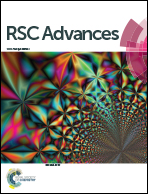High redox activity of Sr-substituted lanthanum manganite perovskites for two-step thermochemical dissociation of CO2†
Abstract
The La1−xSrxMnO3−δ series of non-stoichiometric perovskites (x = 0.35, 0.50, 0.65, 0.80) was examined in the context of solar-driven two-step thermochemical dissociation of CO2. Powder X-ray diffraction and thermochemical performance characterization were performed in order to assess the redox activity of these materials toward thermal reduction under inert atmosphere followed by re-oxidation for CO generation from CO2. To a certain extent, controlled introduction of Sr2+ into LaMnO3 allowed tuning the redox thermodynamics within the series, thus resulting in high activity toward both thermal reduction and CO2 dissociation. La0.50Sr0.50MnO3−δ composition appeared to be the most suitable trade-off for thermochemical CO2 splitting. Maximum CO production of about 270 μmol g−1 was reached during the CO2 splitting step with an optimal re-oxidation temperature of 1050 °C (after thermal reduction under Ar at 1400 °C), although the re-oxidation yield was limited to around 50%. Decreasing the amount of substituted Sr enhanced the re-oxidation yield at the expense of a lower final reduction extent, thus lowering the global amount of produced CO. The evolution of the Mn oxidation state implied partial re-oxidation of Mn3+ into Mn4+, thereby confirming the activation of Mn4+/Mn3+ redox pair in the perovskites. An elevated electronic transfer occurred within the Mn4+/Mn3+ redox pair (superior to that involved in the case of ceria within the Ce4+/Ce3+ redox pair), showing that mixed valence perovskites have clear potential for displaying redox properties suitable for efficient solar-driven thermochemical CO2 dissociation.


 Please wait while we load your content...
Please wait while we load your content...